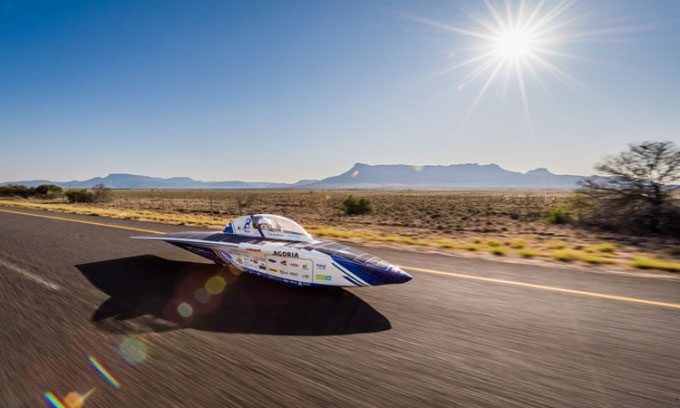Challenges in on-site electricity production and installation costs make solar electric vehicles very difficult to popularize at present.
Solar electric vehicles exist, and the most visible place to see them is the World Solar Challenge, a biennial race held in Australia. Competitors must drive approximately 3,000 kilometers from Darwin in northern Australia to Adelaide in the southern coastal region, using only energy from the sun. Many of the vehicles participating in the race resemble amusement park rides or science fiction cars rather than typical vehicles found on the road. This might explain why solar electric vehicles aren’t yet a viable choice for daily commuting, at least not at present, according to Popular Science.

Solar electric vehicles participating in the World Solar Challenge. (Photo: Composite World).
Although there is plenty of sunlight hitting the Earth each day, it is scattered as it passes through the atmosphere, resulting in relatively low energy reaching the ground. On average, over a year, after accounting for seasonal variations, the energy from sunlight is about 342 watts/m2, which is enough to power a standard refrigerator. Cars come in various sizes, but a large vehicle in the U.S. is about 5.5 meters long and 1.8 meters wide, giving it a surface area of approximately 9 to 10 m2 that can collect around 3,420 watts of energy, sufficient to power a refrigerator, dishwasher, and microwave.
Solar farms transmit electricity to cities and towns using millions of solar panels spread over thousands of hectares. Some facilities in desert areas use mirrors arranged in arrays to concentrate solar energy. However, a standard car does not have enough surface area to collect significant amounts of solar energy.
Another issue is that current solar panels are not very efficient at converting sunlight into electricity. Typically, their efficiency is only about 20%, meaning they convert approximately 1/5 of the solar energy received into electrical energy. This means that 3,420 watts of sunlight hitting a conventional vehicle equipped with solar panels only provides about 684 watts of usable electricity. Meanwhile, an electric vehicle requires 20,000 watts to operate at a speed of 100 km/h.
The vehicles participating in the World Solar Challenge are often very large and designed to maximize surface area. This helps the cars collect as much sunlight as possible. While this approach works for concept vehicles, most of the models do not have windows or any space other than the driver’s seat.
Another challenge is geography, daylight hours, and weather conditions, all of which affect the amount of solar energy that can be generated. The Earth is tilted on its axis, so not every region receives the same amount of sunlight at any given time. When the Northern Hemisphere tilts toward the sun, the upper half of the globe gets more sunlight, while the Southern Hemisphere is colder and darker. Conversely, when the Southern Hemisphere tilts toward the sun, regions there receive more sunlight than those in the northern part of the planet.
Equatorial regions receive abundant sunlight year-round, so areas nearby, like Southern California or the Sahara Desert, have higher solar energy potential compared to places near the poles, such as Alaska. Solar electric vehicles also struggle to gather sufficient sunlight during cloudy or rainy days. Even many large solar farms must plan for times when the sun is not shining. Drivers need to travel at night. To keep solar electric vehicles running after dark, they need to use excess energy collected during the day and store it in batteries. Solar panels and batteries add weight to the vehicle, and heavier vehicles require more energy to operate.
Researchers are working on designing solar electric vehicles that are more suitable for daily use. They need to create more efficient solar panels that convert sunlight into energy effectively while being compatible with cars. Developing a cost-effective system for vehicles is also crucial so that average consumers can afford them.
Currently, the closest alternative to solar electric vehicles is electric vehicles that can be charged at home or at charging stations. Depending on how the electricity is generated, some of the energy supplied to these vehicles may come from solar panels, wind turbines, hydropower, or other renewable sources.


















































